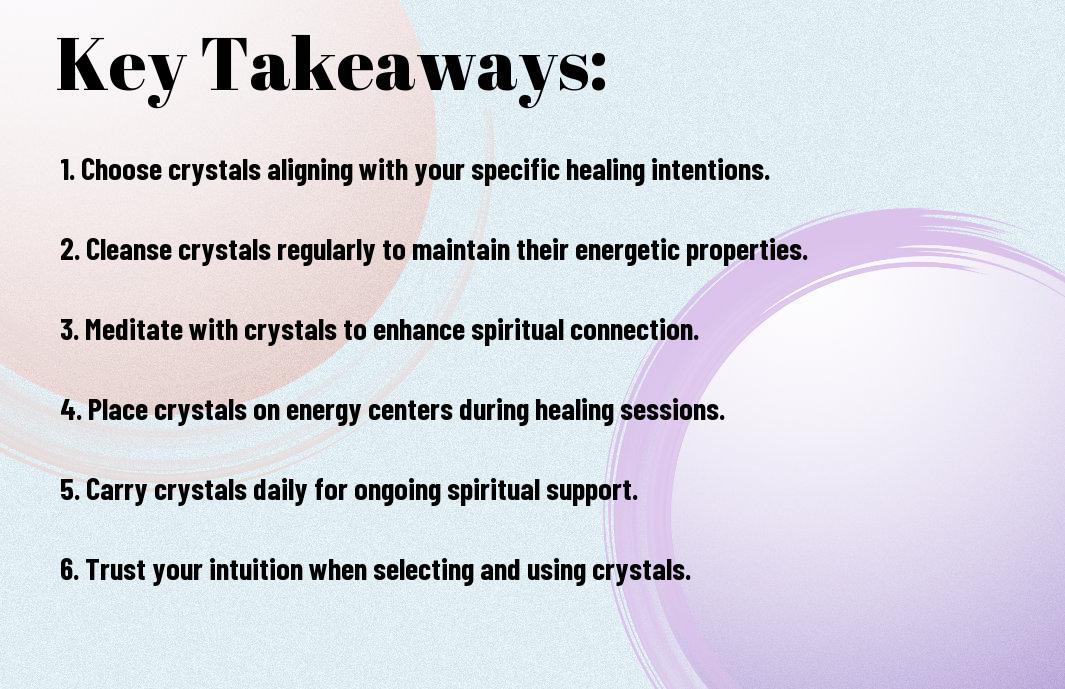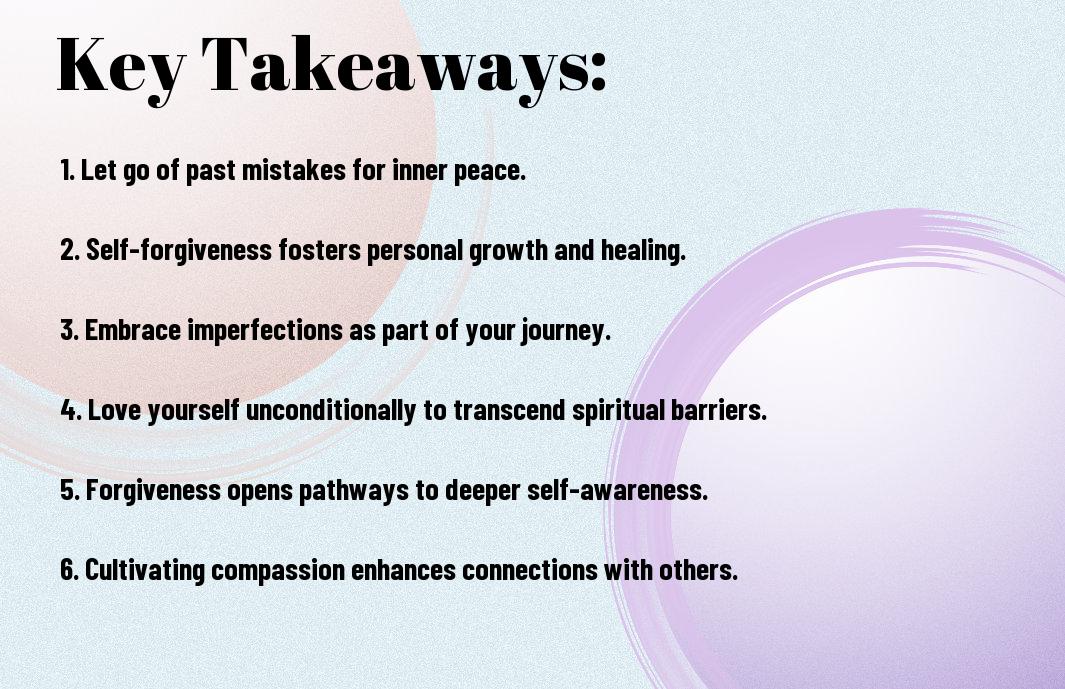Just as you might turn to nature for solace, crystals can serve as powerful allies in your spiritual healing journey. By understanding the unique properties of different stones, you can harness their energy to enhance your well-being. This blog post will guide you through practical ways to incorporate crystals into your life and optimize their healing potential. If you’re new to this world, be sure to check out Healing Crystals 101: Everything You Need to Know for a comprehensive overview.
Key Takeaways:
- Choose the Right Crystals: Select crystals that resonate with your specific needs, such as amethyst for tranquility or rose quartz for love.
- Cleanse Your Crystals: Regularly cleanse your crystals using methods like running water, moonlight, or sage to maintain their energy.
- Set Intentions: Clearly define your intentions while using the crystal to enhance its healing properties and focus your energy.
- Use in Meditation: Incorporate crystals into your meditation practice by holding or placing them nearby to deepen your connection.
- Combine with Other Techniques: Enhance the effects of your crystals through practices like yoga, sound healing, or aromatherapy for holistic healing.
Understanding Crystals
Your journey into the world of crystals begins with an understanding of their unique properties and energies. Crystals are formed from minerals over millions of years and each type is believed to possess certain traits that can resonate with your intentions. By learning about the specific qualities of different crystals, you can harness their energies for your spiritual healing and personal growth. This chapter will probe into the science behind crystals and their historical significance in spirituality, equipping you with the knowledge to select the right crystals for your needs.
The Science Behind Crystals
Around the world, scientists have explored the natural properties of crystals, discovering that they can influence energy fields and vibrations. This is rooted in the concept of piezoelectricity, where certain crystals generate an electrical charge when subjected to stress. This phenomenon may explain why crystals are often believed to have healing or amplifying properties. Understanding these scientific principles allows you to appreciate the potential benefits of incorporating crystals into your spiritual practices.
Historical Uses in Spiritual Practices
Science has shown that cultures throughout history have used crystals for various spiritual and healing purposes. From ancient Egyptians who adorned themselves with lapis lazuli for protection and wisdom to Native American tribes that utilized quartz for rituals, crystals have always held a place in spiritual traditions. These practices highlight the belief that crystals not only have physical properties but also spiritual significance, serving as tools for enhancing mental clarity, emotional balance, and overall well-being.
Even today, many spiritual seekers turn to historical wisdom when using crystals. Throughout the ages, practitioners have believed that certain crystals can facilitate deeper meditation, promote healing, and create protective environments. The use of amethyst for calming the mind or rose quartz for promoting love and harmony reflects long-standing traditions that attribute specific intentions to various stones. By integrating these historical practices with modern knowledge, you can create a personalized approach to spiritual healing through crystals.
Selecting the Right Crystals
Some key factors influence your selection of crystals for spiritual healing, including your personal intentions, specific needs, and the vibrational energy of each stone. Take your time in choosing crystals that resonate with your unique energy, as this connection will enhance your healing experience.
Types of Crystals and Their Properties
Their unique properties can guide you in selecting crystals for various healing purposes. Here’s a brief overview:
| Crystal | Healing Property |
| Amethyst | Calm and balance |
| Citrine | Manifestation and abundance |
| Rose Quartz | Love and emotional healing |
| Clear Quartz | Amplification of energy |
| Sodalite | Communication and intuition |
This provides a basic framework to guide your selection, enhancing your spiritual journey with these powerful energies.
Intuition and Personal Connection
For a deeper connection with your crystals, tune into your intuition when selecting your stones. Trust your feelings and instincts about each crystal’s energy, as this creates a more personalized healing experience.
Another important aspect to consider is how certain crystals may speak to you on a personal level. You might find that some stones draw you in visually or energetically, creating an emotional bond that enhances their healing properties. By allowing your intuition to guide you, you can choose crystals that not only align with your energy but also resonate with your spiritual goals.
Preparing for Spiritual Healing
All successful spiritual healing begins with proper preparation. Taking the time to create a conducive environment and mental state enhances the effectiveness of your crystal healing journey. This phase involves understanding your goals, setting clear intentions, and ensuring that your crystals are ready to work with your energy. By consciously preparing yourself and your space, you optimize the benefits of your healing experience.
Setting an Intention
Beside choosing the right crystals, setting an intention is vital for guiding your healing process. An intention acts as a focal point for your energy, helping you to define what you hope to achieve. Take a moment to meditate on your desires and be specific about the thoughts or emotions you want to address. This clear intention aligns your energy with the healing properties of your chosen crystals.
Cleansing and Charging Crystals
Any effective crystal healing practice requires that you cleanse and charge your crystals prior to use. Cleansing removes stagnant or negative energy that your crystals may have absorbed, while charging revitalizes their natural vibration. Various methods can be employed for this purpose, such as using sage smoke, placing crystals under moonlight, or even using sound frequencies. Consistently cleansing and charging your crystals boosts their effectiveness, ensuring they work harmoniously with your energy field.
Preparing your crystals for healing involves a few simple, yet effective practices. You might choose to run your crystals under cold water, ensuring they are free from any unwanted energy. Alternatively, using sound through singing bowls or bells can also be beneficial. After cleansing, leave your crystals in natural sunlight or moonlight for a few hours to charge them with positive energy. By taking these steps, you elevate the potential of your crystals, allowing them to align with your spiritual healing goals.
Techniques for Using Crystals
Unlike other methods of spiritual healing, working with crystals offers unique techniques that can enhance your practice. You can incorporate them into your daily rituals, carry them with you, or create sacred spaces in your home. By understanding how to use these methods effectively, you can deepen your spiritual connection and amplify the benefits of crystal energy for healing and empowerment.
Meditation with Crystals
Any meditation practice can be elevated by integrating crystals. You can hold a crystal in your hand or place it on your body to focus your energy during meditation. Choose a crystal that resonates with your intention, whether that’s calming, grounding, or enhancing clarity. This connection helps you align your energy and deepen your meditation experience.
Crystal Grids and Layouts
With crystal grids and layouts, you can create a focused intention for a specific purpose. By arranging multiple crystals in geometric patterns, you amplify their energy and direct it toward your intention. Grids can be set up for healing, protection, abundance, or even to enhance your meditation space. The choice of crystals and arrangements can be tailored to resonate with your personal goals.
Understanding the significance of shapes and symbols in crystal grids can maximize their effectiveness. You may use sacred geometric patterns, such as the Flower of Life or a simple circle, to create a powerful energy focus. Additionally, consider the properties of each crystal and how they interact with one another based on their energies. Placing your grid in a space where you spend a lot of time enhances your connection to the energies at play, promoting an environment of healing and intention.
Incorporating Crystals into Daily Life
To enhance your spiritual journey, integrating crystals into your daily life can be transformative. You can start by placing crystals in different areas of your home, using them during meditation, or carrying them with you throughout the day. Incorporating these natural tools can help you maintain focus, promote positive energy, and create a deeper connection with yourself. As you explore various ways to use crystals, you will discover which combinations resonate most with your personal practices and intentions.
Carrying Crystals for Energy
Into your daily routine, carrying crystals can significantly impact your energy levels and emotional state. You can choose small stones that easily fit in your pocket or purse, allowing you to tap into their healing properties whenever needed. For instance, amethyst can promote calmness, while citrine may boost creativity. By keeping these crystals close, you will create a protective aura and harness their vibrational energy throughout the day.
Creating a Healing Space
Creating a healing space in your home can serve as a sanctuary for reflection, meditation, and spiritual growth. This designated area can feature crystals that align with your intentions, enhancing the overall energy of the space. You may decorate this space with soft textiles, calming colors, and items that inspire tranquility. Your healing space should feel inviting and encourage relaxation, allowing you to connect more deeply with yourself and the healing power of your chosen crystals.
Space should be designated for stillness and reflection, ideally in a quiet corner or a comforting room. Start by choosing a flat surface, like a table or shelf, where you can display your crystals. Layer your crystals by size or type to create visual harmony and to enhance their energetic properties. Adding elements such as candles, plants, or soothing artwork can further elevate the ambience, allowing you to settle in and meditate. This intentional environment will support your spiritual practices and invite a continuous flow of healing energy into your life.

Potential Challenges and Considerations
Many people may encounter challenges when using crystals for spiritual healing, such as unrealistic expectations and lack of immediate results. It is important to understand that healing is often a gradual process that requires patience and dedication. Additionally, you may face varying opinions and practices surrounding crystal use, so it’s vital to trust your intuition and remain open to exploring what resonates with you personally.
Misconceptions About Crystals
An array of misconceptions exists regarding crystals; some believe they are mere decorative objects without true energy or healing properties. In reality, while crystals may not replace conventional medicine, they can serve as tools for self-awareness and energetic alignment. Understanding their role in your healing journey is key to maximizing their potential.
Ethical Sourcing and Responsibility
About your use of crystals, it’s important to consider the ethical implications of their sourcing. Many crystals come from regions facing environmental and labor exploitation issues, which can raise concerns about their impact on both the planet and local communities.
Consequently, when selecting crystals for your practice, prioritize those that are ethically sourced. Look for retailers who are transparent about their supply chain, support fair trade practices, and emphasize sustainability. By choosing responsibly sourced crystals, you not only enhance your own healing journey but also contribute positively to the global community and environment.

To wrap up
With this in mind, using crystals for spiritual healing involves setting clear intentions, selecting the right stones for your needs, and regularly incorporating them into your daily practices. You can meditate with them, carry them with you, or place them in your environment to enhance their energies. Trust your intuition to guide you in this journey, and allow the healing properties of crystals to support your spiritual growth and overall well-being. Embrace this holistic approach, and experience the transformative power of crystals in your life.
FAQ
Q: How do I choose the right crystal for my healing needs?
A: Selecting the right crystal for spiritual healing involves identifying your personal intentions and emotional states. Begin by understanding the properties of different crystals. For instance, amethyst is known for its calming energy, while rose quartz promotes love and emotional healing. You can consult crystal guides or seek guidance from a knowledgeable practitioner. Additionally, intuitively selecting a crystal that resonates with you by observing your feelings or attraction towards a particular stone can also be effective. Personal connection is key, so trust your instincts during this process.
Q: How can I prepare my crystals for spiritual healing?
A: Preparing your crystals is vital to enhance their energy and effectiveness. Begin by cleansing them to remove any negative energy they may have absorbed. This can be done through several methods, such as rinsing them in water, smudging them with sage, or placing them under moonlight overnight. After cleansing, you can set your intentions for the crystal by holding it in your hands and visualizing your desired outcome. Some practitioners also recommend charging crystals by placing them on a selenite plate or using sound vibrations from singing bowls.
Q: How should I use crystals in my daily spiritual practices?
A: Integrating crystals into your daily spiritual practices can enhance your overall well-being. You might consider wearing crystals as jewelry, keeping them in your pocket, or placing them in your workspace to maintain their energy throughout the day. Incorporating them into meditation sessions can also amplify your focus and intention. Create a dedicated space at home for crystal display to promote positive energy in your environment. Journaling your experiences with different crystals can help you track your emotional and spiritual growth over time.








